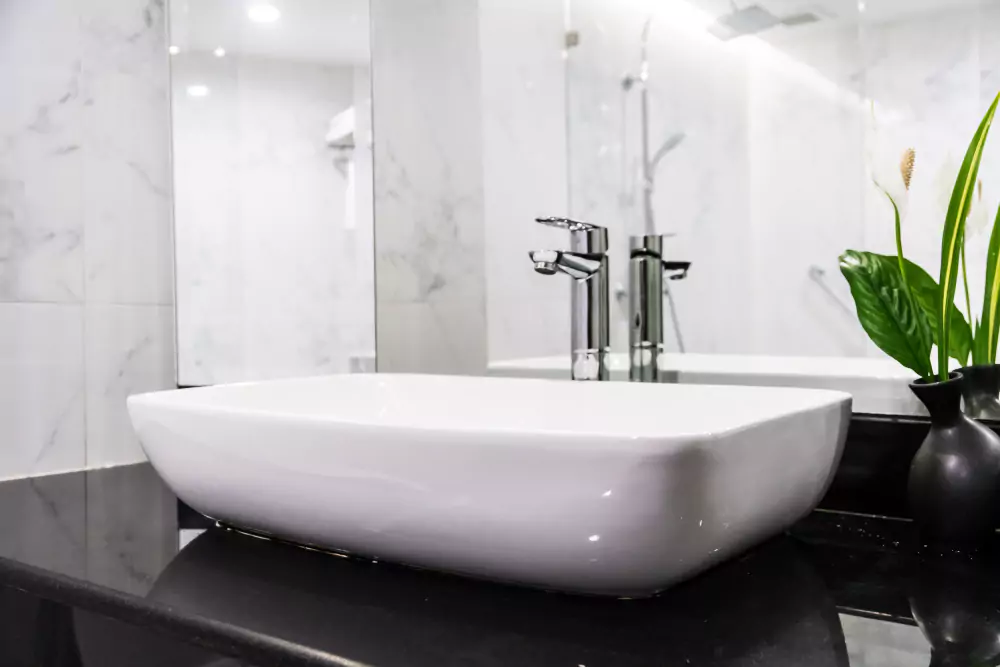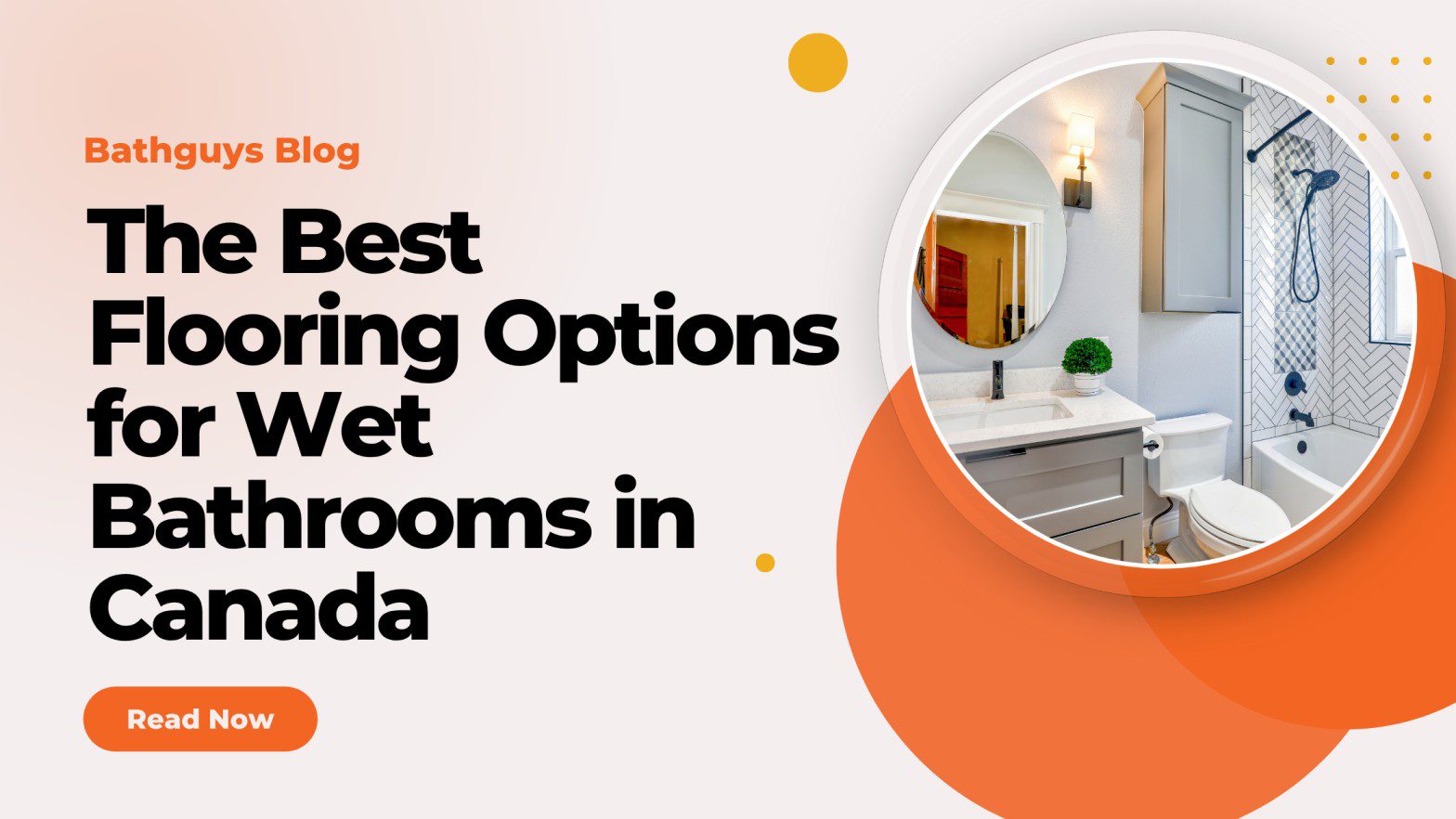Choosing the right flooring for a wet bathroom can feel overwhelming—especially in Canada, where cold winters and high humidity can make the wrong choice costly and uncomfortable. Whether you’re dealing with puddles from daily showers or trying to prevent slips and water damage, it’s important to pick flooring that’s both safe and long-lasting.
In this blog, we’ll explore the best flooring options for wet bathrooms in Canada. From waterproof tiles to modern vinyl and heated floors, you’ll discover practical choices that work for your style, budget, and climate. If you’re renovating or building a bathroom that handles water daily, this guide is here to help you make a smart, worry-free decision.
Table of Contents
Why Choosing the Right Wet Bathroom Flooring Matters
When it comes to wet bathrooms, especially in Canadian homes, the flooring you choose plays a major role in safety, comfort, and long-term durability. Here’s why it’s so important to make the right choice:
Prevents Water Damage
Wet bathrooms are constantly exposed to moisture. Using water-resistant flooring helps prevent mold, rot, and swelling—protecting your home’s structure for years to come.
Improves Safety and Reduces Slips
The right flooring reduces the risk of slips and falls, especially for kids and seniors. Many of the best flooring options for wet bathrooms in Canada come with textured surfaces or slip-resistant finishes.
Handles Canadian Winters Better
Flooring that pairs well with radiant heat or feels warm underfoot can make a big difference during cold months. This is key for comfort in Ontario and other chilly regions.
Lasts Longer with Less Maintenance
Durable materials like porcelain tile or luxury vinyl are designed to handle daily wear and tear. They’re also easier to clean, which helps keep your bathroom looking fresh.
Supports Smart Renovation Investments
Picking the right bathroom flooring adds value to your home. It’s a smart move if you’re planning to stay long-term or sell in the future.
Top Flooring Options for Wet Bathrooms in Canada
If you’re planning a bathroom renovation, choosing the right flooring can make all the difference. Below are the best flooring options for wet bathrooms in Canada, each offering a mix of water resistance, safety, style, and long-term durability.

1. Porcelain or Ceramic Tile
- 100% waterproof and ideal for wet areas like showers and full bathrooms.
- Available in slip-resistant textures and matte finishes for added safety.
- Works well with heated flooring systems—perfect for cold Canadian winters.
- Easy to clean and highly durable, making it a long-term investment.
2. Luxury Vinyl Tile (LVT) or Plank (LVP)
- A top pick for modern homes due to its waterproof core and stylish designs.
- Softer and warmer underfoot than tile, making it more comfortable.
- Slip-resistant surfaces available—great for families and seniors.
- Simple to maintain and more budget-friendly than natural stone or tile.
3. Natural Stone (Slate, Granite, Travertine)
- Offers a high-end look with strong durability.
- Textured finishes provide excellent slip resistance in wet environments.
- Slate and granite are more water-resistant than softer stones like marble.
- Requires sealing to protect against stains and moisture.
4. Sheet Vinyl Flooring
- Seamless installation helps block water from seeping through.
- Available in a wide range of patterns, including wood and stone looks.
- The cushioned feel makes it comfortable to walk on.
- Great for basement bathrooms or lower-budget remodels.
5. Resin or Waterproof Epoxy Flooring
- A seamless, modern finish that’s completely waterproof.
- Extremely durable and easy to clean—ideal for wet rooms or walk-in showers.
- Slip-resistant coatings available for added safety.
- Typically requires professional installation.
6. Rubber Flooring (for Special Use Cases)
- Naturally slip-resistant and soft underfoot.
- Ideal for accessible bathrooms, kids’ bathrooms, or home gyms.
- Water-resistant and easy to clean, but limited in style options.
- More common in commercial or health-focused spaces.
How to Choose the Right Flooring: Comparison Table
With so many options available, it can be hard to decide which flooring is best for your wet bathroom. The table below breaks down the best flooring options for wet bathrooms in Canada, comparing their performance based on the most important factors like water resistance, safety, comfort, and cost.
| Flooring Type | Water Resistance | Slip Resistance | Comfort/Warmth | Maintenance | Estimated Cost (CAD/sq.ft) | Best For |
| Porcelain/Ceramic Tile | Excellent | High (textured tile) | Cool, works with radiant heat | Low | $5–$12 | Durable, stylish bathrooms in any home |
| Luxury Vinyl (LVT/LVP) | Excellent | Good (textured surface) | Warm underfoot | Very low | $3–$7 | Budget-friendly, family-friendly bathrooms |
| Natural Stone | Good (if sealed) | High (textured finish) | Cold, needs heating | Medium (sealing required) | $8–$20+ | High-end, luxury bathrooms |
| Sheet Vinyl | Very good | Moderate | Soft, cushioned | Very low | $2–$5 | Basement or budget wet rooms |
| Resin/Epoxy | Excellent | High (with coating) | Neutral | Low | $10–$18+ | Seamless, modern wet room designs |
| Rubber | Good | Excellent | Soft and warm | Low | $5–$10 | Accessible or kid-safe bathrooms |
Installation Best Practices for Wet Bathrooms in Canada
Proper installation is just as important as choosing the right material. Even the best flooring options for wet bathrooms in Canada can fail if not installed correctly. Below are the top practices to ensure your flooring performs well in wet, humid, and cold Canadian conditions.

1. Start with Proper Waterproofing
- Always apply a waterproof membrane on the subfloor before installing tiles, stone, or vinyl.
- Use waterproofing kits for wet zones like walk-in showers or curbless designs.
- For tile installations, systems like Schluter-DITRA or RedGard are ideal for moisture control.
2. Ensure the Right Slope for Drainage
- Wet bathroom floors should have a gentle slope (usually 1.5%–2%) toward the drain.
- A proper slope prevents water pooling and helps reduce the risk of slips and mold buildup.
- Linear drains or centrally located drains work best in open wet-room designs.
3. Use the Right Adhesives and Sealants
- Choose adhesives specifically designed for high-moisture environments.
- Grout used between tiles should be mold-resistant and sealed regularly.
- For vinyl and sheet flooring, use waterproof adhesive or click-lock systems with tight seams.
4. Pair with Radiant Heat Where Possible
- In colder parts of Canada, underfloor heating systems can improve comfort and help floors dry faster.
- Tile, stone, and vinyl work well with electric radiant heat systems.
- Always follow manufacturer guidelines to prevent damage to heating cables.
5. Opt for Textured or Slip-Resistant Finishes
- When installing tile or stone, choose a textured or matte finish to reduce slipperiness.
- Add anti-slip coatings for resin or epoxy floors to boost safety.
6. Hire a Professional Installer (When Needed)
- For complex materials like epoxy, natural stone, or heated tile, professional installation is highly recommended.
- A licensed installer ensures proper waterproofing, drainage slope, and safety compliance—especially important in Toronto and GTA municipalities.
Using these best practices ensures your wet bathroom is not only stylish but also safe, durable, and built to last in Canada’s unique climate. A well-installed floor will prevent water damage, reduce accidents, and make your daily routine more comfortable.
Maintenance Tips & Winter Care
Even the best flooring options for wet bathrooms in Canada need regular care—especially during the cold, damp months. Proper maintenance not only keeps your bathroom looking great but also helps extend the life of your flooring.
1. Clean Up Water Quickly
- Wipe up standing water after showers to prevent staining or damage—especially on vinyl, natural stone, or grout lines.
- Use a squeegee on tile or glass areas to reduce water buildup and mold.
2. Ventilate the Bathroom Daily
- Use an exhaust fan or open a window after showers to reduce moisture and humidity.
- Good airflow helps prevent mold and mildew, which are common in wet bathrooms during Canadian winters.
3. Seal Porous Materials Regularly
- If you’ve chosen natural stone (like slate or travertine), apply a water-resistant sealant every 6–12 months.
- Sealing helps block moisture, stains, and bacteria from settling into the surface.
4. Use Non-Slip Mats in High-Traffic Areas
- Place washable, slip-resistant mats near tubs, showers, and vanities to improve safety.
- Mats also protect flooring from dirt and salt during winter months.
5. Watch for Winter Moisture from Boots or Towels
- In homes with combined laundry or mudroom bathrooms, avoid bringing in wet boots or snow gear.
- Excess salt or water can stain floors or damage grout over time.
6. Warm It Up with Radiant Heating (Optional)
- If your bathroom includes radiant floor heating, use a programmable thermostat to keep floors dry and cozy during winter.
- Heated floors also help reduce moisture buildup and dry the space faster.
Featured BathGuys Projects & Local Examples
At BathGuys, we’ve helped hundreds of Toronto and GTA homeowners choose the best flooring options for wet bathrooms in Canada, turning outdated spaces into modern, water-resistant, and stylish retreats. Here are a few featured projects that showcase our work and help guide your own renovation decisions:
1. Modern Basement Bathroom in North York
- Flooring Used: Luxury Vinyl Plank (LVP)
- Why It Works: This client wanted an affordable, waterproof flooring option for a small basement bathroom. We used textured LVP that mimicked natural wood, offering slip resistance and warmth underfoot. It was a perfect solution for winter moisture control and everyday use.
2. High-End Ensuite Remodel in Etobicoke
- Flooring Used: Porcelain Tile with Heated Floors
- Why It Works: For this luxury ensuite renovation, we installed large-format porcelain tiles with underfloor heating. This option offered elegance, easy maintenance, and excellent moisture resistance—ideal for high-traffic, wet zones.
3. Compact Condo Bathroom in Downtown Toronto
- Flooring Used: Waterproof Laminate (Special Grade)
- Why It Works: The client wanted a wood-look floor with a low profile to fit under the door. We installed a waterproof laminate that held up well to splashes and high humidity, proving that small bathrooms can still enjoy style and durability.
4. Rental Property in Scarborough
- Flooring Used: Ceramic Tile
- Why It Works: For landlords needing long-term durability on a budget, ceramic tile remains a top choice. The non-slip finish and grout sealant offered extra protection against water damage in this family rental unit.
Why Local Examples Matter
These real-life projects show how choosing the right wet bathroom flooring can transform both the function and value of your space. Each home presents different needs—whether it’s warmth, water resistance, or low maintenance—and BathGuys delivers solutions tailored to our unique Canadian climate.
Conclusion
Choosing the best flooring options for wet bathrooms in Canada is about more than just style—it’s about safety, durability, and long-term value. With so many waterproof and slip-resistant materials available, homeowners in Toronto and the GTA have excellent choices that can stand up to moisture, cold winters, and everyday wear. Whether you’re renovating a small powder room or a full ensuite, the right flooring can elevate both comfort and resale value. From porcelain tiles to luxury vinyl, each option has its unique benefits. By working with an experienced renovation team like BathGuys, you’ll get expert guidance tailored to your needs and budget. Let your bathroom flooring not only look beautiful—but perform beautifully too.
FAQs
What is the most waterproof flooring for wet bathrooms in Canada?
Porcelain and ceramic tiles are among the most waterproof flooring options available. They’re ideal for wet areas like showers and bathroom floors, especially when installed with proper sealing.
Can vinyl flooring be used in wet bathrooms?
Yes, luxury vinyl flooring (LVP) is a popular choice for wet bathrooms in Canada. It’s highly water-resistant, budget-friendly, and available in many styles that mimic wood or stone.
Is heated flooring worth it for Canadian bathrooms?
Heated flooring is a great investment for bathrooms in colder Canadian climates. It adds comfort during winter and works best with tile or stone flooring for even heat distribution.
How do I prevent mold under bathroom flooring?
Use moisture-resistant underlayment and ensure proper ventilation. Waterproof flooring materials like tile or LVP, along with expert installation, reduce the risk of mold growth.
What flooring adds the most value to a bathroom renovation in Toronto?
Porcelain tile often adds the most value due to its durability, premium look, and appeal to homebuyers. However, waterproof vinyl is also gaining popularity for modern bathroom remodels.





